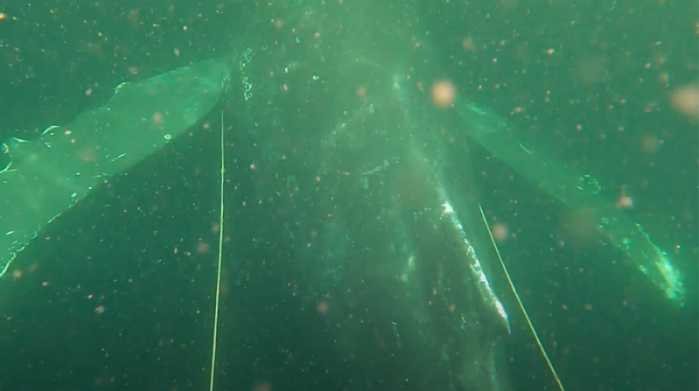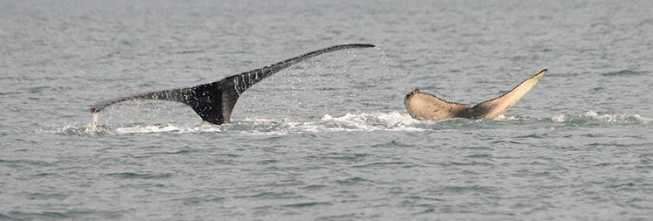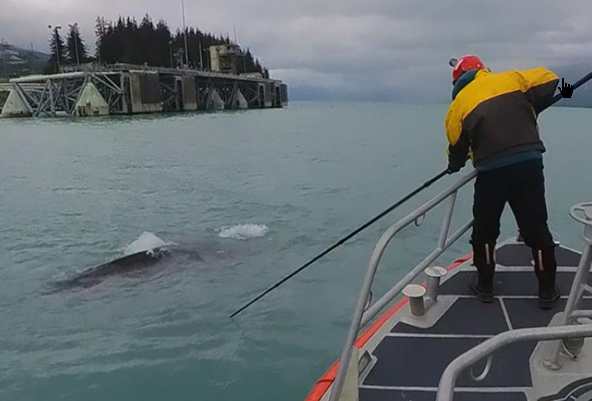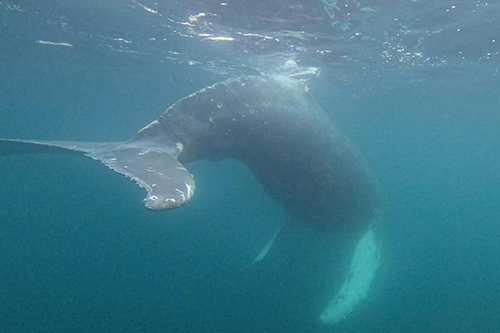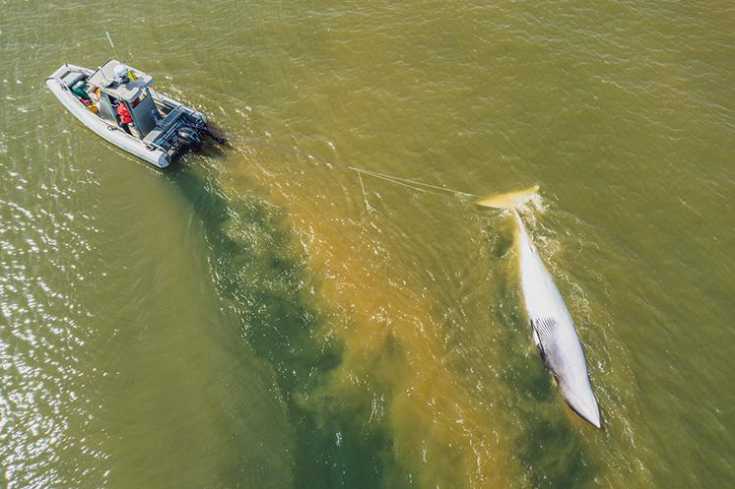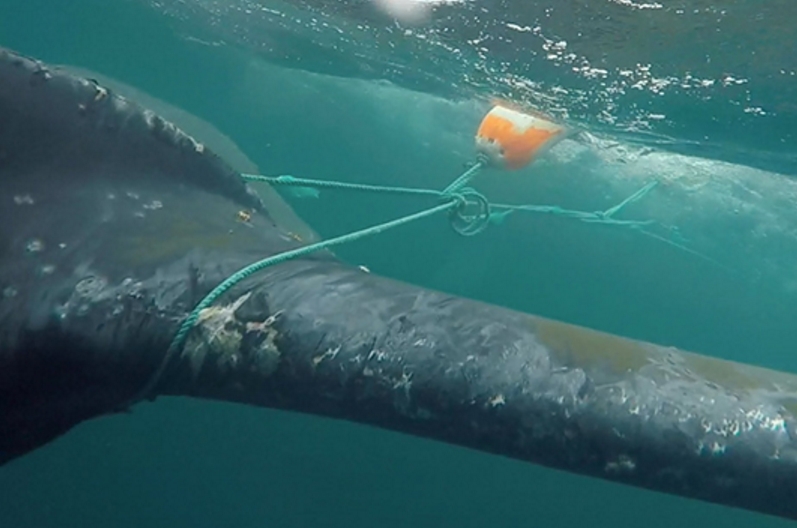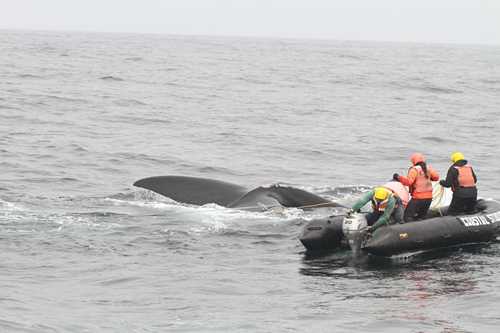Trained responders freed the whale from a life-threatening entanglement near Gustavus
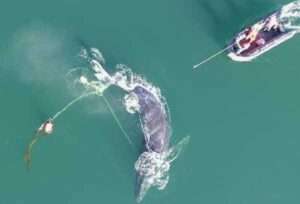
On October 10, NOAA Fisheries received reports of a severely entangled whale in coastal waters near Gustavus. A quick response by a dedicated team of trained responders—involving planes, drones, vessel- and shore-based efforts—helped free the juvenile humpback whale.
“The Glacier Bay National Park entanglement response team was critical in this effort. They provided the vessel and staff to successfully evaluate the whale’s condition and then deployed a team to disentangle the whale,” said Sadie Wright, Large Whale Entanglement Response Coordinator, NOAA Fisheries Alaska Regional Office. “We are grateful to the Gustavus residents who reported the whale in distress, the Alaska Whale Foundation, volunteer Sean Neilson, and support teams within NOAA for their expertise and help in the effort, as well as the owner of the fishing gear who provided information that helped us determine our best approach for freeing the whale.”
Assessing the Whale’s Condition
Janet Neilson and Chris Gabriele with National Park Service’s large whale entanglement response team coordinated shoreline and vessel-based assessments shortly after the first reports of the entanglement. They provided information needed to assemble the right team and equipment to mobilize a timely response.
“Glacier Bay National Park Service personnel located the whale from shore and confirmed it was dragging two buoys. They were able to get out on the water right away to confirm the entanglement and take photos of the animal and gear that helped paint a much more thorough picture,” said Janet Neilson.
Based on the assessment, the team determined that the entanglement was life-threatening. The whale appeared to be semi-anchored in place by line and buoys associated with a crab pot.
“We spoke with the gear owner who was really helpful in providing details that allowed us to better understand the type and configuration of the gear entangling the whale,” said Wright. “The gear included a heavy gauge line and buoys attached to a 300-pound crab pot.”
Deploying the Response Team
A team was deployed from Juneau to Gustavus on the morning of October 11. The team consisted of:
- Core Glacier Bay National Park Service large whale entanglement response personnel
- Advanced responder Fred Sharpe with the Alaska Whale Foundation
- Volunteer photographer and FAA licensed drone pilot Sean Neilson
By 11 a.m., the team was on site and ready to get to work.
To help with assessment and strategy, the response team used a drone to collect aerial photographs and video of the whale. This gave an important perspective on how the whale was entangled. Drone pilot Sean Neilson was able to work from the shore near the boat-based entanglement response effort. He was able to talk to the team over the radio and, at times, return to the main National Park Service vessel to review footage with the team.
“This was a complicated entanglement with a line through the whale’s mouth, and wrapped around the animal’s tail stock,” said Fred Sharpe, advanced large whale entanglement responder with Alaska Whale Foundation. “The drone imagery assisted tremendously with our understanding of the entanglement and how to prioritize our cutting attempts.”
Support teams with NOAA in Juneau, and NOAA whale disentanglement expert Ed Lyman at the Hawaiian Islands Humpback Whale National Marine Sanctuary on Maui assessed the drone imagery. They provided recommendations by cell phone as the team worked with the whale.
The sky was clear and the seas were calm. As the entanglement was so late in the season, mild conditions were fortuitous in aiding the responders efforts to help the whale. Using specialized tools to remove the line and buoys, the team got to work. The response team patiently and deliberately made several cuts using specialized tools designed to keep responders at a safe distance from the whale. This includes a knife on the end of a 25-foot carbon fiber pole and grappling hooks modified with razor-sharp knife blades inside the grapple to cut as they grab. They were able to remove nearly all of the line and the buoys.
Near the end of the day, the strategic approach paid off—the whale became more mobile with each cut of the rope until the gear finally loosened. “The turning point came when we were able to cut the rope that ran through the whale’s mouth and was wrapped around its tail,” said Gabriele, a whale biologist with Glacier Bay National Park and Preserve.
The whale was able to swim away, leaving the buoys and most of the line floating at the surface. While all of the floating portions of the line were collected, the pot hasn’t been recovered yet. It is likely sitting on the seafloor where the whale was last seen.
The next day, Janet Neilson matched photos of the entangled whale’s fluke pattern to a known individual, SEAK-5490. This young whale was first documented by the Alaska Whale Foundation in 2021 and had been seen twice in the Glacier Bay area earlier in 2023. The Happywhale website uses computer algorithms to match humpback whale flukes and help track individual whales through contributed sightings. You can view photos and “follow” this whale to be notified of any future sightings.
“Glacier Bay National Park staff plan to look for this animal in the coming weeks and document its condition if it is still in the area, and NOAA Fisheries staff will continue to seek resights to hopefully confirm the animal is in good condition and back to normal feeding and migration,” added Wright.
“The Alaska teams have been busy this summer with multiple responses in Southeast Alaska. This disentanglement response went very well due to the dedication and expertise of a number of organizations and personnel. Their training and commitment paid off, and helped this whale survive,” said Ed Lyman, who acts as a regional large whale entanglement response coordinator under NOAA Fisheries’ Marine Mammal Health and Stranding Response Program. Lyman has been leading large whale entanglement response trainings in Alaska for more than 15 years. He led a refresher course for Glacier Bay National Park staff in 2022. Due to the risks involved to animals and responders, NOAA’s Marine Mammal Health and Stranding Response Program oversees and authorizes large whale entanglement response efforts nationally.
What to Do if You See an Entangled Whale
If you see an entangled whale, do not approach it. Contact experts who have the training and specialized equipment to respond. Getting too close to a very large and likely distressed animal can be dangerous—even life threatening. Entangled whales frequently avoid boats after repeated close encounters, making disentanglement efforts even more difficult. Cutting visible gear off can actually make things worse, so it’s best to keep your distance and leave it to the experts.
To help an entangled whale, call NOAA’s 24/7 entanglement hotline at (877) 9-AKR-PRD ((877) 925-7773), or hail the U.S. Coast Guard on VHF Channel 16 and they will relay the report.
If you’re interested in learning more about becoming a first responder, take the online training developed by NOAA in partnership with The Nature Conservancy. It will teach you how to more effectively document and communicate with NOAA to help free entangled whales. These reports are the best way to help the animal. The information gained also helps us better understand entanglements and how to reduce entanglements and their impacts in the future.
[content id=”79272″]

